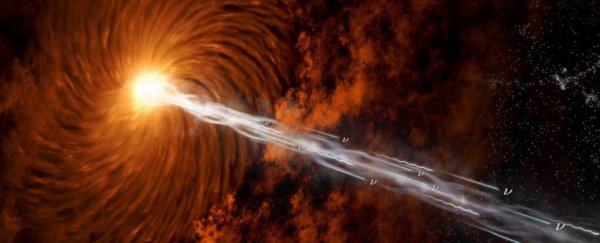Some of the brightest, most energetic objects in the Universe are the mystery source of high-energy cosmic neutrinos, new research has confirmed.
A comprehensive analysis has pretty conclusively linked galaxies hosting blazing nuclei known as blazars with these enigmatic particles.
It's a result that provides a really unexpected solution to a problem that has had astrophysicists scratching their heads for years.
"The results provide, for the first time, incontrovertible observational evidence that the sub-sample of PeVatron blazars are extragalactic neutrino sources and thus cosmic ray accelerators," said astrophysicist Sara Buson from Julius Maximilian University of Würzburg in Germany.
Neutrinos are weird little things at the best of times. These subatomic particles are ubiquitous and among the most abundant in the Universe.
However, their mass is almost zero, they're electrically neutral, and they interact very little with anything else in the Universe. To a neutrino, the normal matter of which most of the Universe consists might as well be a shadow; this is why they are known as ghost particles.
We know pretty well where neutrinos – normal neutrinos – come from.
They're produced by radioactive decay, which is pretty common. Most of the neutrinos we detect at Earth are by-products of nuclear reactions in the Sun, but they can also be produced by supernovae, artificial nuclear reactions, or the interaction between cosmic rays and atoms, for example.
But a special observatory in Antarctica revealed some really bizarre ones.
Although neutrinos don't interact much with normal matter, every now and again, they do. When they interact with molecules in water atoms, they can produce a very small flash of light.
The IceCube Neutrino Observatory has detectors embedded deep in the Antarctic ice at the south pole that can detect these flashes. These detections can reveal the energy of the neutrino.
In 2012, IceCube detected two neutrinos that were like nothing we'd ever seen. Their energies were on petaelectronvolt (PeV) scales – 100 million times more energetic than supernova neutrinos. And these high-energy neutrinos had come from intergalactic space, source unknown.
We got a hint as to that source in 2018. Because neutrinos don't interact, they pretty much travel on a straight line through space – so a huge international collaboration of scientists was able to trace a high-energy neutrino back to a blazar.
That's the nucleus of a massive galaxy powered by an active supermassive black hole, angled so that jets of ionized matter accelerated to near light-speed point directly at Earth.
"It is interesting that there was a general consensus in the astrophysics community that blazars were unlikely to be sources of cosmic rays, and here we are," University of Wisconsin-Madison physicist Francis Halzen said at the time.
Still, some questions remained about the association between blazars and high-energy neutrinos. So a team of scientists led by Buson did what scientists do: they went a-digging.
They took 7 years' worth of all-sky neutrino data from IceCube, and painstakingly compared it against a catalog of 3,561 objects that are either confirmed blazars, or highly likely to be.
They performed positional cross-matching of these catalogs, trying to determine if high-energy neutrinos could be conclusively linked to blazar locations in the sky.
"With this data, we had to prove that the blazars whose directional positions coincided with those of the neutrinos were not there by chance," explained astrophysicist Andrea Tramacere of the University of Geneva in Switzerland.
"After rolling the dice several times, we discovered that the random association can only exceed that of the real data once in a million trials! This is strong evidence that our associations are correct."
According to the team's analysis, the probability of a random occurrence is 0.0000006. This suggests that at least some blazars are capable of producing high-energy neutrinos, which, in turn, helps solve another problem. The origin of high-energy cosmic rays – protons and atomic nuclei that stream through space at close to the speed of light – is also a huge mystery.
According to Buson, high-energy neutrinos are produced exclusively in processes that involve the acceleration of cosmic rays. This means, by inference, that we can now link blazars with cosmic ray acceleration, the team said.
"The accretion process and the rotation of the black hole lead to the formation of relativistic jets, where particles are accelerated and emit radiation up to energies of a thousand billion of that of visible light!" Tramacere said.
"The discovery of the connection between these objects and the cosmic rays may be the 'Rosetta stone' of high-energy astrophysics."
From here, there are several avenues that warrant further exploration. One is to try to discover why some blazars are efficient particle accelerators while others are not. This will help the team work out what the characteristics of a neutrino factory are, and where else in the cosmos we might find them.
In addition, further, more detailed analyses of neutrino data may yield more discoveries about the birthplaces of these peculiar, ghostly particles.
The research has been published in The Astrophysical Journal Letters.
